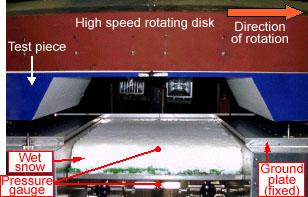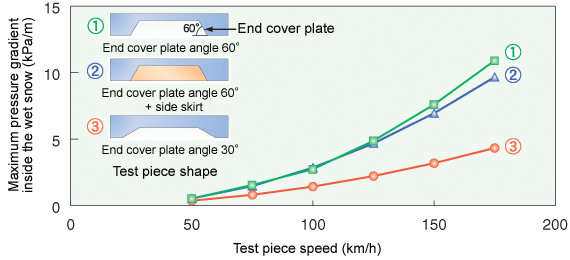| 9. Body Shape Near the Bogie to Control the Splashing of Wet Snow | |
|
Snow thrown up by a high-speed train may adhere to a vehicle and accumulate, causing ballast to be thrown up when the accumulation drops from the vehicle. To combat this, train speed is decreased, leading to delays during snowy weather or in areas where snow has settled on the ground. To contribute to the improvement of speed control in snowy conditions, an experiment was perormed usuing a model to examine how the splashing of wet snow was affected by different shapes of body near the bogie. It was noted that irregularities in the shape of the bogie edge made it difficult to control snow accumulation by simply makng the edge smooth. To control the splashing of wet snow, it is necessary to reduce the pressure gradient generated inside the wet snow by rapid pressure fall when a train passes. This gradient was therefore measured by running test pieces (scale 1/5, Fig.2) of various body shapes near the bogie of the Shinkansen over wet snow at speeds of 50-175km/h using a high-speed rotating disk device (Fig.1) in a low-temperature laboratory. The measurements showed that, compared to the test piece representing the current Shinkansen (1), reduction of the maximum pressure gradient was recognized in the test piece with a side skirt (2) and in test piece (3) with an end cover plate angle of 30üŗ (Fig.2). Test piece (3) in particular showed a remarkable reduction at low speeds, indicating the possibility of controlling the splashing of wet snow.  Fig.1 High speed rotating disk device used in the experiment  Fig.2 Maximum pressure gradient inside the wet snow |